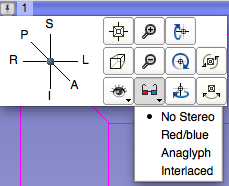Documentation/Nightly/SlicerApplication/StereoViewing
|
For the latest Slicer documentation, visit the read-the-docs. |
Purpose
Slicer has the capability to display data in the 3D Viewer stereoscopically in a number of fashions including Red/Blue, Anaglyphic, Interlaced. These rendering modes are automatically enabled.
The final mode, called QuadBuffer, will be enabled if Slicer detects that your hardware can support it.
Stereo Modes Explained
The first two algorithms require only 3D glasses, not any special computer hardware configurations. The last two algorithms require special stereo-ready display systems:
Red/Blue - For use with red/blue glasses commonly available in magazines or on the internet (see http://www.3dglassesdirect.com) The scene is drawn twice (once in each color from the location of each eye). Using the glasses separates the views and recreates perspective. There is some "bleedthrough" of the images to the opposite eye, but users can generally see depth using this algorithm. The drawback to this algorithm is the natural color of objects is lost due to the red & blue only rendering.
Analglyph - This algorithm uses the same glasses as the red/blue algorithm but preserves much of the natural color of rendered objects. In general, this preserves the colors in the rendered scene, but adds depth. Some "bleedthrough" still occurs between the eyes, but there are less visual artifacts compared with the red/blue algorithm.
Interlaced - In this algorithm the pixel lines from each eye are intermixed as the picture is rendered from top to bottom. With an ordinary monitor the lines will seem "jaggy" because we are observing the left and right eye's version of the scene superimposed. However, a stereo image results when interlaced signals are fed to a specially-configured stereo monitor or stereo display panel. The Hyundai S465D is one example of a panel with a vertical interlaced rendering mode.
QuadBuffer - Available only when automatically detected. Formally called "CrysalEyes" named after the famous, legacy glasses now sold by RealD (please see the products at the following website: http://www.reald.com/Content/Crystal-Eyes-5.aspx ). This mode can enable "active stereo", "frame sequential stereo" or "passive stereo " depending on how the video drivers are configured. Only some graphics cards support OpenGL quad buffer technology such as professional graphics cards such as NVIDIA Quadro or ATI FireGL. Not all display devices support this rendering mode.
